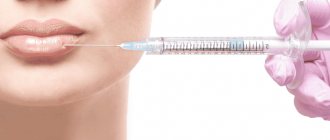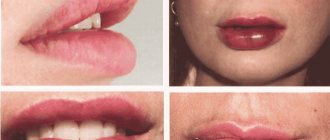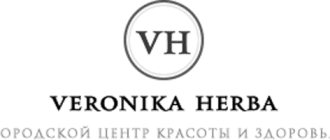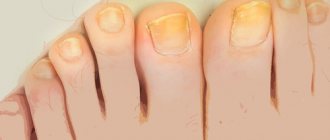Types of facial fillers and their features
Fillers are usually divided into two categories - biodegradable
(they are based on hyaluronic acid, based on calcium hydroxyapatite CaHA and collagen-containing) and
permanent
(based on synthetic polymers).
Towards biodegradable
(temporary) are fillers based on hyaluronic acid, collagen and calcium hydroxyapatite; they are absolutely harmless and are removed from the body on their own after a few months. The components of biodegradable fillers not only smooth out wrinkles and unevenness, but also moisturize the skin from the inside, replenishing moisture deficits in the cells, as a result the skin becomes elastic and attractive.
· hyaluronic fillers
There are monophasic and biphasic hyaluronic fillers. Monophasic fillers consist of hyaluronic acid molecules of the same size, biphasic fillers contain hyaluronic acid with different molecular sizes. These fillers are used to restore volume, fill wrinkles, and create a clear facial contour.
· collagen-containing fillers
The basis of biodegradable collagen-containing fillers is collagen, a fibrillar protein that forms the basis of the body’s connective tissue and ensures its strength and elasticity (bones, cartilage, dermis). These fillers are used to correct wrinkles and create clear facial contours.
Calcium hydroxyapatite preparations
Calcium hydroxyapatite is a natural human component; for fillers it is synthesized biosynthetically. In cosmetology, such fillers are used for face lifting and long-term correction of wrinkles. The effect of hydroxyapathic fillers can last up to 2 years.
Non-biodegradable or permanent fillers
– These are fillers based on synthetic compounds – polymethyl methacrylate (PMMA) and polydimethylsiloxane (silicone). Such drugs are prohibited for use in cosmetology in some countries due to the high risk of side effects and possible complications. Fillers based on synthetic compounds are not able to be eliminated from the body on their own; only a doctor can remove them. Today, such fillers are practically not used in modern cosmetology.
In aesthetic cosmetology, biodegradable fillers are used - they are absolutely safe for the body, and in addition to eliminating skin imperfections, they can significantly moisturize it. Hyaluronic acid, collagen and calcium hydroxyapatite are independently produced in the body and are part of the tissues, which completely eliminates the risk of incompatibility or rejection. With age, the production of hyaluronic acid and collagen in the body decreases; fillers can fill these deficiencies in the body, thereby restoring moisture and elasticity to the skin.
Conclusion
The dermal filler market has expanded significantly in recent years.
Currently, fillers can not only smooth out wrinkles, but also restore volume in many areas, thereby changing the overall condition of the face. However, to achieve decent results, the doctor must have a thorough understanding of the individual characteristics of the materials used, including indications, contraindications, as well as the prevention and treatment of any possible side effects, if they are unavoidable.
There is not a single filler that does not have side effects, but the likelihood of their occurrence is sharply reduced if the specialist is familiar with the range of both the fillers themselves and the means that stop their effects. Also, thanks to a deep knowledge of anatomy, mastery of various techniques and the ability to create an individual treatment plan for patients, almost all serious side effects can be avoided.
Source: Prime International Journal of Aesthetic and Anti-Aging Medicine
Share:
Date of publication: 11 October `17
Impact zones
Hyaluronic fillers can transform the following areas of the procedure:
— forehead and eyebrow area
The upper part of the face is most often subject to deep wrinkles, which are formed due to active facial expressions and frequent tension of the forehead. Injections smooth out deep wrinkles and creases, filling them with a gel-like composition.
— lips, corners of lips
Hyaluronic fillers give lips extra volume and moisturize them. Also, with the help of fillers, it is possible to correct lip asymmetry, raise the corners of the mouth, as a result, the face looks more youthful.
— cheek and cheek area
Fillers replenish volume, restore clarity to the face and emphasize the cheekbone line. Injections into the cheekbones not only make them clearer and more expressive, but also tighten the skin on the cheeks and along the jawline, as if lifting the skin of the face upward.
— eye area
The skin of this area is thinner, so it is susceptible to facial wrinkles and age-related changes earlier than other areas of the face. Fillers smooth out wrinkles in the corners of the eyes and nasolacrimal grooves.
— nose
Today, fillers are an excellent alternative to plastic surgery. They are able to relieve the patient of a hump on the bridge of the nose, as well as make the wings of the nose symmetrical.
— folds in the area of the nasolabial triangle
This area of the face is the main sign of age, making the face look tired and mature. Fillers smooth the skin from the inside out, giving the face a more youthful appearance.
— chin
Using fillers, volume is added to the chin and horizontal creases are removed. It is also possible to remove the hole if it is an aesthetic drawback for the patient.
— Jolie angles or youth angles
(scientific name: mandibular angles)
With the help of fillers, it is possible to correct the angles of the lower jaw. A clear line of the lower jaw with pronounced angles visually makes the appearance more sophisticated, feminine and emphasizes youth.
Depending on the area, fillers of different densities are selected - high, medium or low. Therefore, the introduction of fillers must be carried out by a professional specialist. You should not trust your face to untested cosmetologists who do not have sufficient experience, qualifications and knowledge.
Fillers based on hyaluronic acid –
Hyaluronic acid fillers are most often used to eliminate cosmetic defects. They are easy to use and do not require too much training from a doctor. Hyaluronic acid is a polysaccharide that is constantly synthesized by skin cells. Its biological role is to moisturize the skin and give volume to the skin, which becomes possible due to the fact that its molecules are able to hold a volume of water - 1000 times greater than the volume of the molecules of the polysaccharide itself.
The “lifetime” of hyaluronic acid molecules in the body is no more than 24-48 hours, which is why so-called “bound hyaluronic acid” is used for the production of fillers. It is a gel in which single molecules of hyaluronic acid are linked to each other (using special substances) in long chains, which prevents its rapid destruction. After being introduced into the tissue, such a gel retains its elastic structure and volume for a long time, which makes it possible to use it to correct wrinkles and add volume to facial tissues. The duration of the effect is usually about 6 months, but for some drugs the effect lasts up to 9-12 months.
Type of hyaluronic acid filler –
Below we list the most popular hyaluronic acid fillers, but in general there are a very large number of them, and they all have different properties. For example, one of the most important characteristics of a filler is its elasticity (density). High-density fillers are used to eliminate deep wrinkles and folds. Slightly less dense ones are intended to create volume in the cheekbones and cheeks, and very soft ones are used in the lips and eyes. In Table 1 you will find information about filler brands and for which areas of the face they are recommended.
1) Restylane® filler (Restylane) –
Restylane contains non-animal hyaluronic acid obtained through bacterial fermentation. The manufacturer is Q-Med (Sweden). This is the most popular filler in the United States (approved by the FDA in 2003). It has a high concentration of hyaluronic acid - 20 mg per 1 ml. Restylane refers to incompletely hydrated gels, i.e. During the first 24 hours after injection, it will absorb moisture, which will lead to additional expansion of the soft tissue at the injection site.
Due to the fact that the gel has medium density and elasticity (gel viscosity corresponds to 100,000 particles per 1 ml), it is well suited for the correction of wrinkles of medium depth. The effect after its administration lasts from 6, but not more than 8 months. This drug is ideal for reducing the depth of nasolabial folds, marionette lines at the corners of the mouth, nasal defects, acne scars, as well as for lifting the tip of the nose.
In addition to the classic Restylane® filler, there are also several options that are more adapted to specific tasks: 1) “Restylane Touch” - for eliminating the smallest wrinkles, 2) “Restylane Lip” - for correcting lip volume, 3) “Restylane Sub-Q” - to create additional volume in the cheekbones and cheeks. All these preparations contain the same concentration of hyaluronic acid, and differ only in the density/elasticity of the gel. The cost of 1 syringe with a volume of 1 ml for clinics is from 6,000 rubles, which in our opinion makes this filler the best in terms of price/quality ratio. In clinics the price starts from 10,000 rubles.
A big plus of Restylane brand fillers is that the manufacturing company tests its fillers for residual content of bacterial proteins. This is important because Almost all fillers are now produced by bacterial fermentation, and residual proteins can cause the risk of allergic reactions. For example, the popular Juvederm fillers do not undergo such laboratory tests. However, there are no comparative data in the literature on the frequency of allergic reactions of different brands of fillers.
→ Restylane® filler release forms
2) Perlane® filler (Perline) –
Perlane filler was also developed by Q-Med (Sweden). It is part of the Restylane® line of fillers, differing from them in higher viscosity and gel density. At the same time, the concentration of hyaluronic acid in it is the same - 20 mg per 1 ml. This filler is FDA approved and is designed to treat only severe deep wrinkles and folds of the skin. The duration of the effect is about 9 months after the injection (sometimes longer).
This gel is an excellent option for reducing the severity of nasolabial folds, increasing the volume of the cheekbones, reducing deep wrinkles on the chin, and marionette lines in the corners of the mouth. In general, to successfully work with this drug, the doctor must have extensive experience in using fillers, because Perlane has a very high density. Using such a gel with insufficient experience can lead to the skin surface being uneven (lumpy). The cost of 1 syringe with a volume of 1 ml is about 7,000 rubles, and in clinics the cost usually starts from 12,000 rubles.
3) Juvederm® filler (Yuvederm) –
Juvederm is one of the most popular fillers in Europe and the USA. Manufacturer: Allergan Inc. (USA). Contains hyaluronic acid obtained using bacterial fermentation technology. The gel is not fully hydrated, so additional expansion should be expected in the first 24 hours after injection. Two forms of Juvederm® filler were approved by the FDA in 2006: Juvederm Ultra and Juvederm Ultra Plus. They correspond to those released for Russia - “Juviderm Ultra 3” and “Juviderm Ultra 4”.
In Juvederm Ultra 3 and Juvederm Ultra 4, the concentration of hyaluronic acid is the same - 24 mg / 1 ml, but they differ from each other in the density of the gel. Juvederm Ultra 4 gel is the densest and is used to correct deep wrinkles and folds, as well as atrophic scars. The slightly less dense Juvederm Ultra 3 is used to correct wrinkles of medium depth, but it is also suitable for working with the contour of the red border of the lips. Moreover, both of these gels are equally suitable for increasing the volume of the cheekbones, reducing the depth of nasolabial folds, as well as for marionette wrinkles.
The cost of 1 syringe with a volume of 1 ml (depending on the form of release) ranges from 7,000 to 13,000 rubles, and accordingly in clinics the price will start from 12,000 rubles for the most inexpensive option - Juvederm Ultra 2, used for lips and wrinkles around the eyes . The duration of the effect of Juvederm Ultra 3 is similar to Restylane® filler and is 6-9 months, but the effect of Juvederm Ultra 4 will last up to 12 months. Additionally, there are 5 more variants of this filler, designed for narrow areas of application (you can check them out at the link below). These include -
- Juvederm Ultra 2,
- Juvederm Voluma,
- Juvederm Ultra Smile,
- Juvederm Volbella (Volbella),
- Juvederm Volift (Volift).
→ Juvederm® filler release forms
4) Filler Belotero (Belotero) –
Belotero filler was created by the Swiss company Anteis SA, but currently the owner of the brand is the pharmaceutical company Merz (Germany). Belotero is positioned as a “smart filler” that has a unique degree of homogeneity and the ability to be evenly distributed in tissues. This will ensure that you don't feel it on your skin. Has FDA approval. The line of this filler is represented by 3 drugs - Belotero Soft, Belotero Balance and Belotero Intense.
Belotero Soft – contains 20 mg/ml3 of hyaluronic acid, and is intended for the correction of fine superficial wrinkles, as well as delicate areas of the face, neck and décolleté with thin skin. Belotero Balance – contains 22.5 mg/ml3 hyaluronic acid, and is used to correct medium-sized wrinkles and folds, as well as lip augmentation. And the third option - Belotero Intens - with 22.5 mg/ml3 of hyaluronic acid, for the correction of deep wrinkles and folds, as well as increasing the volume of the cheekbones and cheeks. The effect lasts approximately 6-9 months. The cost of 1 syringe with a volume of 1 ml is about 6,000 rubles.
→ Cost in clinics – from 11,000 rubles per 1 ml.
5) Filler Stylage –
Stylage® filler is produced by the French company VIVACY Laboratories. Stylage filler has a whole line of drugs. First up is a line of 3 Stylage® fillers - lettered S, M and L. They target fine superficial, medium and deep wrinkles, respectively. The effect of Stylage® S lasts up to 9 months, and M and L - up to 12 months. Each gel version is available with or without lidocaine.
The second option is a soft filler called Stylage Lips, which contains 18.5 mg/ml3 of hyaluronic acid and is intended only to increase the volume of the body of the lips and/or contour their red border. The effect lasts about 6 months, sometimes longer. Well, the third option is Stylage XL and XXL fillers, which are designed to add volume to the cheekbones and cheeks. The effect lasts about 12 months (24stoma.ru).
The manufacturer, as one of its competitive advantages, claims to contain antioxidants (mannitol and sorbitol), which slow down the destruction of the hyaluronic acid gel. However, the process of destruction of hyaluronic acid gels in tissues depends on many factors, and antioxidants are not the main ones. The manufacturer does not publish comparative studies on this issue with other fillers. The cost of Stylage® S,M,L is about 3500-4000 rubles (for 1 syringe). The cost of other forms is about 5,500 rubles per 1.0 ml syringe. In proportion to this, you can calculate the price in clinics (usually + 5,000 rubles to the cost of the drug).
6) Princess® and Hyalax® fillers –
Both Princess filler and Gialax filler are produced by the same company Croma-Pharma (Austria). There are 2 release forms in the Princess line of fillers. The first option is the classic Princess Filler®, this is a fairly soft filler that can be used for superficial and medium wrinkles, as well as for lip augmentation. To correct deep wrinkles and nasolabial folds, increase the volume of the cheekbones and cheeks, you can use a denser version of this drug - Princess Volume.
The effect of classic Princess filler will last 4-6 months. The effect of the second filler option will last up to 6-9 months. It must be said that this brand is the most inexpensive among fillers. Cosmetology clinics buy them - only 3,000 and 3,500 rubles, respectively (for a 1.0 ml syringe), and the low price allows for a higher markup. For comparison, the purchase cost of 1 1.0 ml syringe of Juvederm Ultra 3 is about 11,000 rubles.
It should be noted that for Princess fillers (in comparison with those listed above), very few clinical studies have been published, and with not too many people who took part in them. However, if you want to save money or get acquainted with the contouring procedure for the first time, you may well choose this particular brand. By the way, another economical option is the “Revofil” line of fillers (Fine, Plus and Ultra), made in Korea. Their purchase price for a 1.0 ml syringe is also only about 3,100 rubles.
Contraindications
Despite the safety of this rejuvenation technique, there are a number of contraindications to its implementation:
· autoimmune and oncological diseases, diabetes mellitus, chronic diseases during exacerbation
diseases associated with blood clotting
· colds (flu, acute respiratory infections, acute respiratory viral infections)
· herpes in the acute stage
allergic reactions to drugs used in fillers
· pregnancy and lactation period
· skin damage in the correction areas
· recently performed other cosmetic procedures: peelings, photorejuvenation, techniques involving laser effects on facial skin
Where are filler injections given?
Where there is no required volume:
- bridge of the nose;
- Nasolacrimal cavity;
- Eyebrow area;
- Cheekbones;
- Nasolabial groove;
- Nose (including tip);
- Lips;
- Chin;
- Angles of the lower jaw;
- “Rings of Venus” - transverse wrinkles on the neck.
Does it hurt?
During the procedure, superficial anesthesia is applied, and pain is possible - everything is individual.
Isn't this dangerous?
No. Don't be afraid. Hyaluronate is produced in the human body. Therefore, the injected fillers are not rejected and do not cause allergic reactions.
There is no need to worry about medical errors. Cosmetologists have been taught the correct technique and methods for introducing fillers for more than a year. Specialists know the anatomy of the face very well, so the risk of hitting a nerve or large vessel is negligible (a doctor simply wouldn’t even be given a license to practice without knowing the basic basics).
Can contouring not give results?
The effect may be too weak. This may be due to the small volume of the injected drug or the characteristics of the body: too active blood flow in the treated area or very active enzymes that destroy hyaluronic acid.
Disguising lower eyelid hernias is also ineffective. This area often swells, so a cosmetologist is not an important assistant here; you should contact a surgeon immediately. The surgical intervention is simple, performed without incisions and long-term hospitalization.
Do fillers provide a moisturizing effect for lips?
Yes, hyaluronic acid has the property of “attracting water,” thereby producing a moisturizing effect.
Also, some fillers contain glycerol or mannitol, which provide prolonged hydration.
At what age is it better to start doing contouring?
Depends on what exactly you want to do for yourself.
You can fix a hump or add volume to your chin even at 18 years old.
Facial filler injections are not wrinkle prevention! The drug only fills the empty space underneath. In all other cases, be careful and consult your cosmetologist. And remember that in pursuit of fashionable beauty you can only ruin everything.
Are there any contraindications to contour plastic surgery?
Yes. Basic:
- Pregnancy,
- Breastfeeding period
- Exacerbation of chronic diseases,
- Inflammation or violation of the integrity (cuts, scratches, burns, cracking, etc.) of the skin in the injection area,
- Mental illnesses.
Can there be side effects after filler injections?
There will definitely be swelling. A puncture with a needle is a tissue injury, to which the body responds with swelling.
There may be hematomas. It all depends on the anatomy of your face. The facial part is richly supplied with small vessels. Sometimes the plexuses are so dense that it is impossible not to touch the vessel. A hematoma is blood that has spilled from a vessel and accumulated under the skin. Hematomas occur especially often (80%) when fillers are injected into the lips.
What should I do if I don't like the result?
The filler can be removed.
Contact the cosmetologist who performed contour plastic surgery on you. Discuss with him what you are not satisfied with and agree on a repeat procedure. The enzyme hyaluronidase is also injected subcutaneously, which destroys filler molecules.
How does the procedure work?
Before carrying out the filler injection procedure, a detailed consultation with a doctor and diagnostics are required - identifying the characteristics of the skin, the patient’s needs, and eliminating contraindications.
The duration of the procedure is from 15 minutes to an hour, on average 30 minutes.
Stages of the procedure:
· cleansing the facial skin, marking and placing points in the areas of filler injection
The doctor shows the patient a syringe with the drug - its integrity, dosage and expiration date.
· pain relief
An anesthetic is applied to the skin of the face - a drug that can cause a decrease in sensitivity. In addition, some filler compositions include analgesic components, making the injection procedure virtually painless.
injection of fillers
The drug is injected using a very thin needle to a certain depth, which depends on the composition, the desired result and the severity of the skin defect. The technique of administration also varies and is determined by a cosmetologist.
· facial massage for even distribution of filler
The final effect appears after two weeks.
Recovery period
· It is not recommended to touch your face on the first day after injections
· Swelling is possible in the affected areas. It is not recommended to eat salty and spicy foods, so as not to complicate or prolong the recovery period
· At first you should refrain from decorative cosmetics - foundation and powder. It is necessary to exclude lotions and tonics containing alcohol.
· for two weeks you should refrain from visiting the bathhouse, sauna, solarium; in addition, peelings and scrubs are prohibited
· for 3-4 weeks it is not recommended to massage the area where fillers are introduced
After two weeks, the tissues are completely restored, and the result is maximally visible.
How long does the effect last?
The duration of the effect of fillers is very individual and depends on many factors, these include the composition and density of the active substance, the characteristics of the body, the patient’s lifestyle and habits.
As a rule, the effect of the procedure lasts up to 1 year, then the drug gradually disintegrates without harm to the body.
It is important that the filler injection technique is correct; the result and duration of the effect depend on this. Even hyaluronic fillers have to be removed without waiting for natural disintegration if an excessive amount of the substance was injected or the injection technique was violated. Therefore, an experienced, qualified doctor is the main component of the desired and lasting result.
Contour plastic surgery of nasolabial folds: price
For contour plastic surgery of nasolabial folds, the price in professional dermatological clinics starts from 10,000 rubles (for 2022). The final cost will depend on the brand and volume of filler. For example, the cost of correction when using 1.0 ml of Juvederm Ultra 3 or Ultra 4 will be about 13,000 - 14,000 rubles, Restylane or Perlane - 16,000 rubles.
The cost of services from private cosmetologists is usually somewhat lower, but we immediately draw your attention to the fact that too low prices can only indicate the use of counterfeit drugs, the volume of use of which, according to statistics, already reaches 40% of the total volume of drugs. For example, the cost of the Juvederm Ultra 3 filler alone is about 7,000 rubles, and the Restylane line of drugs ranges from 8,000 to 10,000 rubles. Therefore, if you are offered a final cost of 7000-8000 rubles, then this is only possible if you use counterfeit drugs or fakes.
Pros and cons of the procedure
The undeniable advantages of the filler injection procedure are:
· virtually painless procedure and elimination of general anesthesia
short recovery time
natural breakdown of the filler and removal of the drug from the body without surgical intervention
The disadvantages of the filler injection procedure include:
· short-lived result: the drug is eliminated from the body after 6-24 months
· if necessary and the desired result is achieved, a repeat session can be scheduled
· if the filler injection procedure is performed by an inexperienced specialist, side effects are possible
Possible allergic reactions











